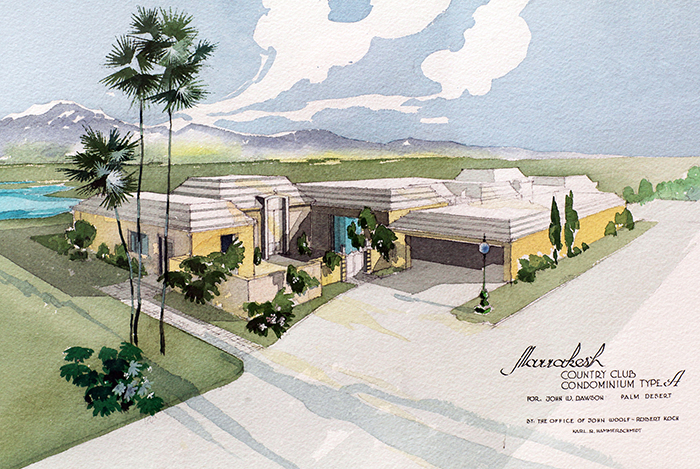John Elgin Woolf’s last major commission was the Marrakesh Country Club in Palm Desert, California. The project was the dream of golfer and visionary real estate developer, Johnny Dawson (1902-1986). A Chicago native who won a scholarship to the School of the Art Institute of Chicago, Dawson took a part-time position with famed sporting goods manufacturer A.G. Spalding to support his studies. Dawson soon left behind his artistic aspirations to travel the golf circuit enlisting professional endorsements for Spalding. This was the beginning of a long and successful amateur golf career that brought Dawson to Southern California and introduced him to the celebrities and investors that were transforming the arid Coachella Valley into a verdant, desert playground. Throughout the 1950s and 60s, Johnny Dawson achieved legendary status as the developer of California’s finest residential golf resorts. In 1967, he acquired a one hundred and fifty-five acre parcel in Palm Desert with spectacular views of nearby snowcapped mountains. The vista was a familiar one to Cliff Henderson, founder of Palm Desert, who related his experience of serving under General Patton in WWII and seeing the setting sun over the Atlas Mountains turn the walls of Morocco’s fabled city a dazzling shade of pink. Dawson was inspired to name his new country club Marrakesh. Marrakesh Country Club would be the jewel in his crown, and for that he needed an architect with a winning reputation. Dawson and his investors selected Beverly Hills designer John Elgin Woolf.
By the time he was hired in 1968, Woolf was widely known and admired, and his designs were regularly featured in Architectural Digest, Town and Country, and Vogue. What set Woolf apart from his Mid-Century Modern contemporaries was his Hollywood Regency style with its references to French and English Regency architecture and Greco-Roman elements. Woolf’s restrained opulence was seen as a welcome change from the austerity of the Mid-Century Modern architecture that had become synonymous with Palm Springs living. Woolf brought his signature design elements to the project – soaring Pullman entry doors flanked by slender columnettes rising to meet a pop-up French mansard roof. Woolf infused a cohesive design sensibility into every detail of this planned community consisting of three hundred and sixty-four spacious homes separated into fourteen neighborhoods; each consisting of two dozen homes, a pool and a pool pavilion. He personally designed the one hundred and fifty-four streetlights, and, at Dawson’s request, every home was painted the color that would become known as Marrakesh pink. In 1971, John Elgin Woolf was diagnosed with Parkinson’s disease and architect Richard Harrison, formally of Wexler and Harrison, was brought in to take over the design of the Marrakesh clubhouse. However, its distinctive water feature, a staple of Middle Eastern design, can be attributed to Woolf.
Marrakesh Country Club was the culmination of Johnny Dawson’s dream to bring the elegant lifestyle enjoyed by the wealthy to everyone. In conjunction with the exhibition, John Elgin Woolf: Master of Hollywood Regency, Palos Verdes Art Center purchased a Woolf-designed property at the Marrakesh Country Club as the Grand Prize in its 2015 Mid-Century Desert Dream House Raffle. As a tribute to Woolf’s vision, the interior has been artfully furnished in the spirit of Hollywood Regency by the New York – Los Angeles design firm Bureau de Decoration. Proceeds from the raffle support the exhibitions and education programs of the Palos Verdes Art Center.
Gail Phinney
Director of Education
Images of the Marrakesh house below-

